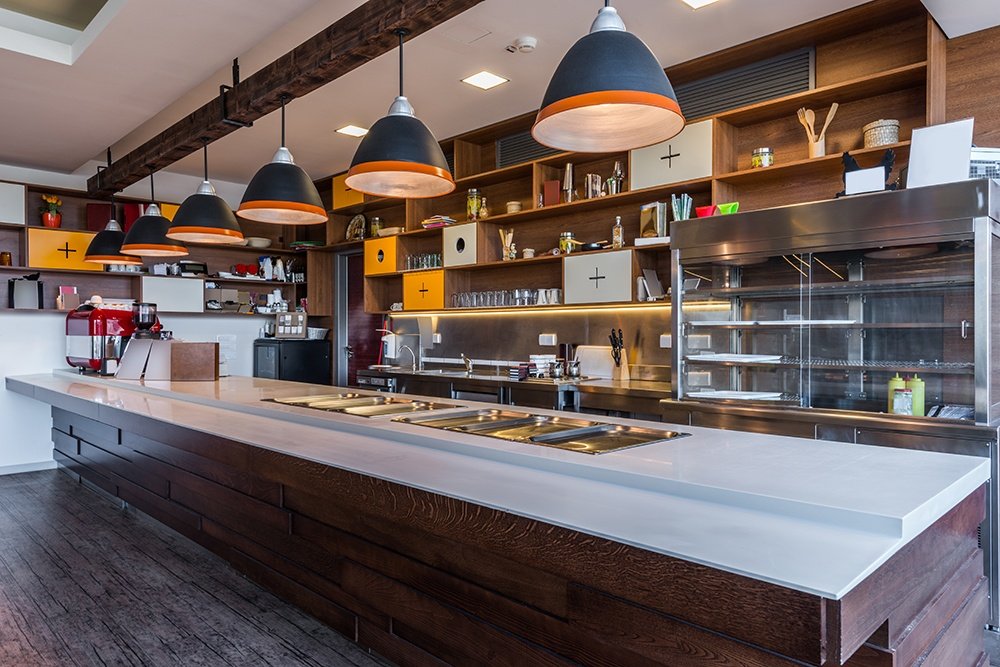How you present your fast casual restaurant menu board and what you include on your digital menu can have a significant impact on how customers view your food, what they order, and how much they spend.
To understand how to create a digital menu board that leads to more sales, check out these quick design tricks you can use to improve your customer ordering experience and your bottom line.
Place your best-selling items in the center of the menu.
Your fast-casual menu board should be designed to maximize sales. This means you should feature your best-selling items prominently along with your most-profitable items. Ideally, these items would be the same, meaning customers are most likely to buy items that will drive the most revenue to your restaurant.
For many fast casual restaurants, the most profitable items are combo meals. For an extra few dollars, customers can add sides and drinks to their orders, increasing their tickets without increasing the cost to the restaurant. This is why combos are typically presented as the best deal for customers — and are almost always placed as the main option to choose from.
Most customers understand the concept of a combo meal, which means they don’t have to think too hard about what they want.
The placement of these best-selling items on your fast casual restaurant menu board can have a significant impact on your bottom line. The fast-casual Mexican chain Taco John’s recently simplified its signage from three panels to two. It also increased the visibility of its EZ Combos to better catch the customer’s eye.
In the test markets, these small changes boosted store sales by 12%. The company has plans to roll out the menu boards to its remaining 100 locations and is hoping for similar results. As Taco John’s proves, the way to present your menu items to your customers can make or break your sales.
Add decoy items to draw customers to your main options.
When customers approach a fast casual restaurant menu board, they mentally calculate the value offered for the cost. This is the reason why dollar menus are increasingly popular: customers perceive the cost to be minimal but the reward to be high. However, this can pose a problem for businesses who want customers to choose more expensive items (or at least upsize to a combo meal) instead of simply opting for the cheapest offering. This is where your decoy meals come in.
Decoy meals are expensive offerings that aren’t featured as prominently on the menu.
The goal of these expensive meals is to make the main items seem more affordable. For example, if a fast casual hamburger restaurant wanted to promote a $7 burger, then it would offer a $12 super burger or $10 fish and chips option as a comparison. Suddenly, the main $7 meal doesn’t seem so expensive — especially when the customer can add a side and drink for only $3 extra.
Along with decoy meals, many restaurants include larger drink sizes to make the medium and large sizes seem more affordable. Starbucks is the quintessential example of this. Most customers order grande beverages because the venti sizes seem too large and expensive.
A few years ago, Starbucks introduced the trenta, and suddenly a venti seemed much more affordable and reasonably-sized. This allowed Starbucks to upsell beverages even if customers weren’t actually buying trenta-sized coffee and tea.
The decoy menu items move customers toward the center menu items that you want them to order in the first place.
Differentiate between your promotional and traditional menu.
Most fast casual restaurant menu boards have two different types of offerings: the year-round menu and the seasonal or promotional menu. The year-round menu features your best-selling items (as discussed above) and answers questions about the price, calories, size, and even ingredients of your options. In the fast food world, these items include the McDonald’s Big Mac or the Chick-Fil-A chicken biscuit.
Outside of your traditional menu items fall your promotional or seasonal items. These include pumpkin spice lattes, summer smoothies, and the McRib in the case of McDonald’s. These items are new, limited, and a reason to bring customers into your restaurant.
Both of these menu items are important for your digital signage. Your traditional items provide the bulk of your sales while your promotional items bring customers back more than they normally would. However, they should be kept apart in your display.
Promote your special items as customers enter the restaurant and get in line, but focus on more traditional items as the customer approaches the counter. This reduces confusion and allows your customers time to think and to make decisions more easily.
Test what works for your fast casual restaurant menu board.
One of the greatest benefits of digital menu boards is the ability to instantly change what you’re advertising with minimal cost and effort. You can set up different fast casual restaurant menu boards at your various locations or franchises to test which designs draw the most sales and creates the best results. Just like Taco John’s, you might find hidden sales opportunities just by investing in digital signage that you can change easily.
Try to run tests between various locations, days, and even hours to see how customers respond to your menu.
You may find that sales of a particular item spike just because of a better design or promotion during a different time. To make it easier to run your tests, customize your digital sign using time and day parting so the content adjusts and changes on its own.
Start using smart digital menus in your fast casual restaurant.
As you can see, the right content on a digital menu can help you increase both sales and customer experience. If you’re interested in learning more about how you can bring this technology and strategy to your fast casual restaurant, contact us today or click the button below to get our ultimate guide to getting started with digital signage.
